Ice, Fog, and Kayaks
Thunder boomed across the water, roaring and thudding through the foggy silence that surrounded us. But it wasn’t thunder. It was ice. Icebergs, to be precise. Icebergs the size of Costco stores, and they were breaking up and crashing into the water where we kayaked. We turned towards the sound and positioned our tiny boats to ride out the wave generated by the breakup of the beasts. We didn’t know if it would be large or small – we just knew it was coming.
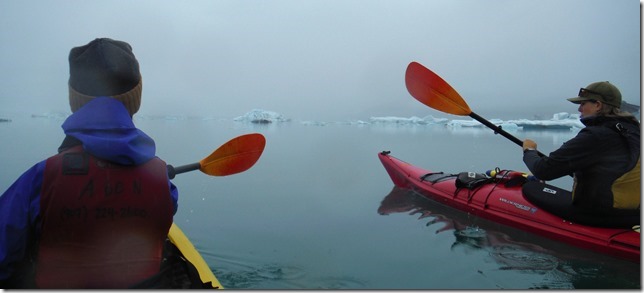
Karin and I had been thinking for some time about kayaking around the toe of a glacier. Alaska is rife with glaciers, and many of them terminate at the ocean (tidewater glaciers) or into lakes. In July, we had just missed an opportunity to kayak near the Portage glacier, but weather blocked us.
Near Seward, where we were camped in early August, there are several tidewater glaciers. They can be visited by taking lengthy boat trips out 50 to 80 miles. But we were less interested in the boat trips, and didn’t relish the O’dark-thirty departures, so we elected for the shorter fly-in route. We booked a helicopter to Bear Glacier, a lovely 20-minute flight along the rugged coast south of Seward.
We were slightly hesitant about the weather, which had turned decidedly low and rainy. Was it a bad time for flying and kayaking? Turns out that helicopters can make child’s play out of weather that would keep fixed-wing pilots (like me) on the ground. And (we were told) the fog and overcast tend to enhance the glacier experience with their soft lighting, not to mention the usually calm waters that attend a light rain. We decided on a guided tour for such strange waters – one of our better decisions on this long northern sojourn.
One further factor enticed us to fork out the $550 apiece – just recently, there was a modest earthquake in the vicinity of the Kenai peninsula, and huge amounts of ice had been shaken off the fronts of glaciers. We would be in for an ice-intensive visit, far different from the few spots of white we saw over at Portage.
Thus it was that, with stuff packed in dry-bags, wet-water gear donned, and big grins on our faces, we climbed into the Robinson R44 and lifted oh so easily into the air above Seward.
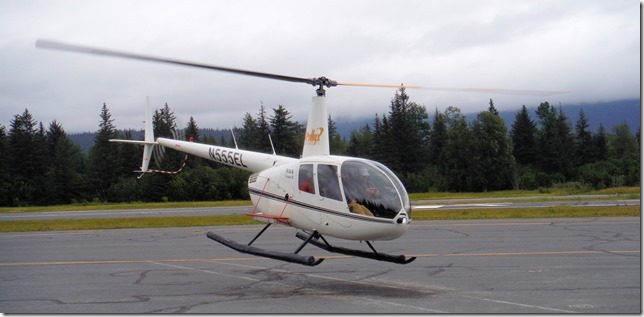
The little four-seater effortlessly floated us over the buildings and boats and out along the shore. Turning westward over the water where Bear terminates, we got our first glimpse of the ice-strewn, fog-enshrouded lagoon.
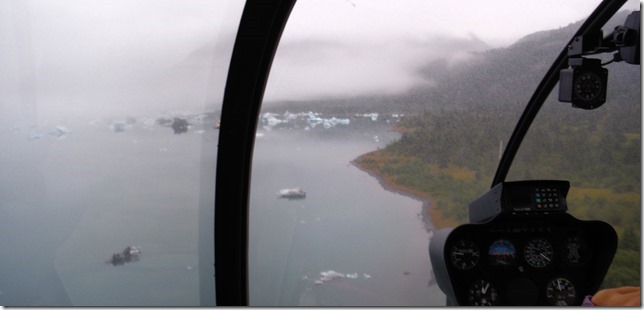
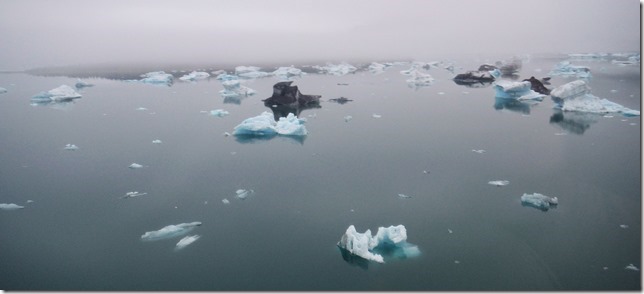
After what seemed like minutes from take-off, we swooped down onto a microscopic patch of beach on the glacier lagoon, scarcely enough room to put up a backpacking tent. Helicopters are just magical machines. (The kayaks had been brought in previously by boat, and were stacked up beyond the brush line.)
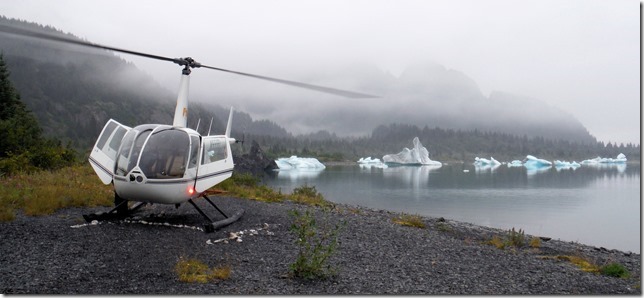
Unload the gear, wave good-bye to the pilot, and we were alone. There’s a heightened sense of that aloneness when dropped off in the bush, especially by aircraft. You know you’re a really long way out, and totally dependent on your support group to get you back.
Fog and scud surrounded us while we prepped the boats and ourselves, climbing into spray skirts and packing the boats. Libby, our guide, was a tall, amiable blond who was nearly as excited as we were to be out there. She ran us through the drills on kayaking and following her instructions (this turned out to be really important). And off we launched, into the still cold waters of the lagoon, Libby in the lead. She was a spectacularly good guide, well-versed in the wonders, and the safety issues, of what we were undertaking. Psychology instructor in the winter, guide in the summer, certified in guiding, kayak instruction, medical and rescue, we couldn’t have asked for a finer shepherd for our day. Cute, too.
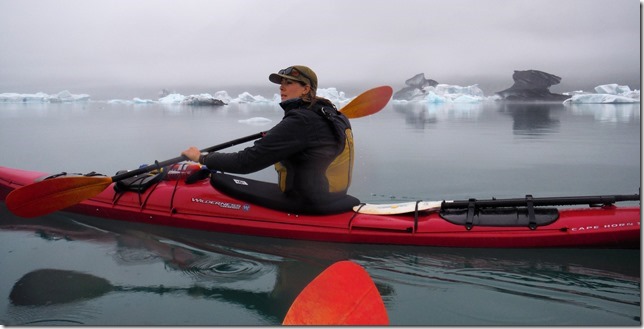
The ground fog at first hid Bear Glacier from our view, but we were surrounded by its products. There were more than a thousand pieces of ice way larger than our boat, and maybe a hundred or more big enough to cause real trouble. The lagoon was so full of icebergs that it was difficult to plot a course. You see, you don’t just paddle nonchalantly on by these overgrown ice cubes — you can end up in real trouble, or dead.
Icebergs are inherently unstable in the water. They are very irregular in shape, and they can even have more than one position in which they will float. Then, after a while, the part that’s in the water melts faster than the part in the air, and the bottom gets skinnier than the top. That’s when the fun begins. At some point, the iceberg gets too top-heavy, and rolls over to a new position. This is not always a peaceful event.
The other aspect of instability is that these huge chunks of ice are simply too big for their own strength. The mass of the ice is often so great that it fractures itself just by its own weight. When this happens, the results are simply stupendous. A chunk of ice the size of a supermarket starts to break up, with house-sized pieces fracturing off the sides, and the whole affair becomes radically unstable. Hundreds of tons of ice start crashing into the water and rolling upside-down. The noise is like listening to jets fly in a thunderstorm.
And so we paid close attention to Libby’s directions about where to go and how much safety distance to maintain. Basically, anything that stuck above the water more than a couple of feet was suspect, and to be given a respectfully wide berth.
The shapes and surfaces are varied literally without limit, no two alike. Holes, peaks, slabs, ripples, pedestals, you name it, you’ll find it in an iceberg field. Here’s a catamaran-like structure that seemed to appeal to the seagull on top.
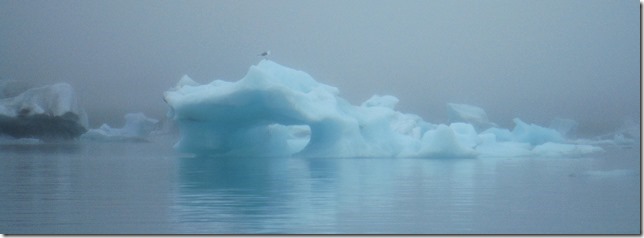
Along the way, some non-threatening ice frequently bumped the kayaks. These small chunks I immediately called “cocktail ice”, and Libby grinned and said yes, they often made “glacier-ritas” from them. An example in miniature, twisted and carved by the vagaries of the rippling waters. Remember the 10:1 rule? When we picked up this piece of ice, only the tips were showing above the water.
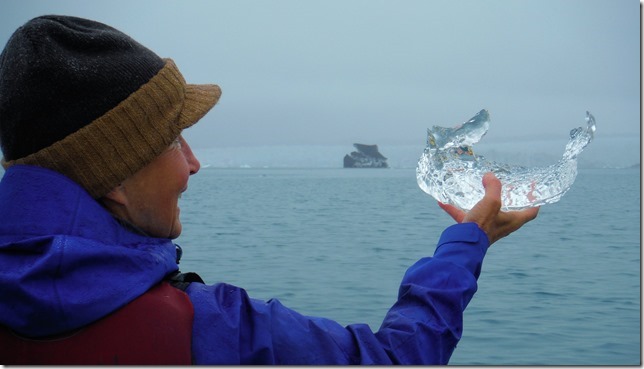
We paddled a safe distance away from an iceberg the size of a two-story house. It was sitting quite placidly, but was making on ominous sound. The ice was clearly under strain, and the noise was like bacon frying in a pan, a hissing crackling “let’s get outa here” message that had us increasing our stroke to stay clear.
That one didn’t break up, but many, many others did. We would be easily paddling along, and suddenly there would be an urgent splashing and whooshing sound behind us. We’d look around and yet another beast had turned over in its sleep, rocking and rolling for many minutes afterwards.
All day, the fog and rain kept my waterproof camera drenched. The camera didn’t care, but the water droplets on the lens made for the poorest picture collection I’ve ever had to post. My apologies, but those were some of the most difficult conditions for photography. My much-needed sunglasses were also useless, and tucked up into my hat. During a quiet spell, Libby shot this rain-blurred pic of us against the frigid back-drop.
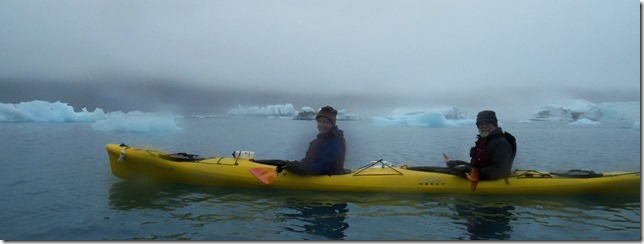
All afternoon, the fog had been coming and going, changing positions. It was as if the glacier was “breathing”, and in fact that huge thermal mass was doing just that, in a weather sense. It was spooky, mysterious, ethereal. It was also a bit scary when the big strange noises came booming out of the fog. Was that a nearby small noise or a far-away big noise? Hard to tell.
When a big breakup occurred, we’d hear it, but not necessarily be able to see it. And if you can’t see it, you can’t see the mini-tidal-wave that comes from it. We found ourselves many times pointing our boats at where a sound came from, trying to gauge its distance and the size of wave we might expect.
Out further into the lagoon, the edge of the glacier began to appear through the fog. With everything so unstable, this was as close as we dared go, about two hundred yards or so. Getting close to a calving glacier in a kayak is the ultimate no-no.
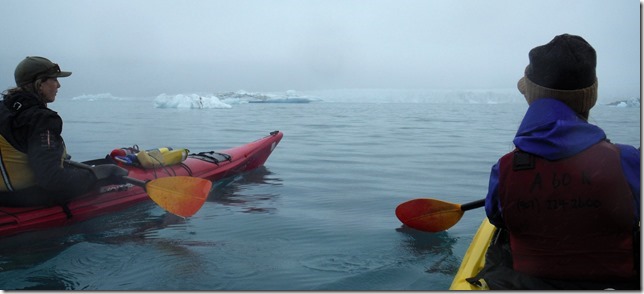
As we took a shore-line lunch break, the fog lifted for a brief photo opportunity.
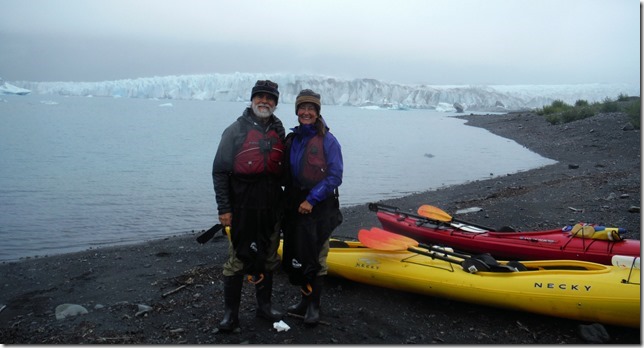
The biggest surprise of the day came with a huge disintegration at the far edge of the glacier. I knew that it would create a sizeable wave, but I foolishly misestimated how long it would take to reach us. Trying to get some pictures, I was distracted from my photography by Libby’s shouted “I WANT YOU TO PADDLE NOW!!”. I dropped the camera and grabbed my paddle in time to see a two-foot-high wave coming at us. We paddled like demons, but didn’t quite get pointed into it when it struck our boat. The water flowed up over the top of the kayak and across our bellies, filling our spray skirts with lagoons of their own. But we still had full control, and paddled through it, with never any risk of over-turning the kayak. We were quite happy about keeping the boat upright, since the icy water was around 40F – no fun for a swim.
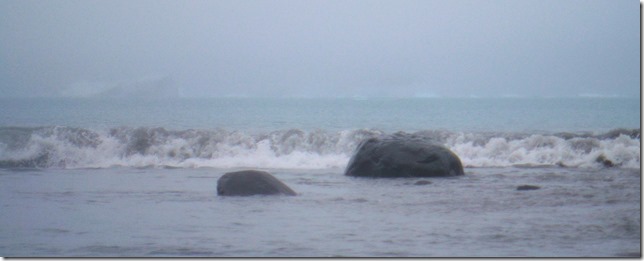
After that, we got even more focused on listening and watching. The big breakup, and its wave action, seemed to set off instability all over the lagoon. We spent the next hour and a half listening to crash after thunderous crash. Even the quieter upheavals were spectacular to watch, with barn-sized ice blocks rolling and rocking in the water. One low-profile, innocuous little iceberg rolled upside-down as we looked at it, and tripled its above-water height! There is no predicting these things, and we worked carefully to keep our distance.
Oddly enough, the harbor seals seemed to have some sense of when big things were about to happen. We’d see absolutely nothing in terms of seal life, and then three, four, or five of them would show up. They’d swim about somewhat aimlessly for a few minutes and then disappear. Shortly afterwards, another behemoth would thunder and crack and roll over. It was positively eerie – it happened to us three different times.
Here’s an example, but unfortunately I can only show you the aftermath. The blue iceberg on the left was almost twice the height of the dirty one on the right. As we were watching, the face of the blue ‘berg started to crack and craze, turning a pale blue-white from the bottom up. Like a science-fiction movie’s special effects, the white crazing ran all the way up the entire face of the iceberg, accompanied by the most bizarre series of cracking, booming, gunshot cacophony of sounds you could possibly imagine. Along with the booming and blasting came huge vertical splits and massive fracturing, with entire thirds of the block shearing off and collapsing into the lagoon. We paddled furiously to get out to a safe distance, maybe 300 yards, and then turned around to await the inevitable wave. It came, but the water was deep and the wave was more of a large swell, non-breaking and benign. You never can tell. I think the pounding of our hearts may have competed with the booming ice there for a minute or two. After things settled down, this low mound was all that was left.
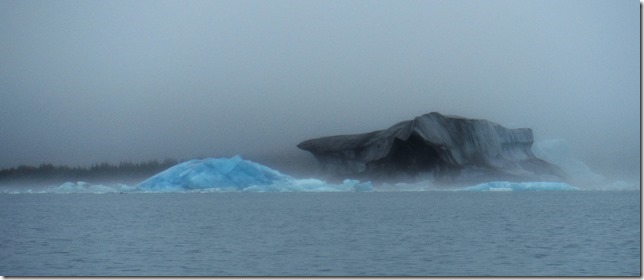
As the afternoon waned, we headed back to our pick-up point. But by this time, multiple big icebergs had drifted down across our previous course. It was so littered with big ice that Libby had to impose a no-photography, hi-speed regimen for us to quickly negotiate the more risky stretches toward “home”. And let me tell you, when that gal called for no-nonsense speed, that’s what we gave her. Those big sea kayaks go straight and fast, and we pulled that beast along as best we could, probably 4-5 knots or so, to scoot through the hazard zone. My muscles are reminding me of the effort as I type this.
We got through the tight section and relaxed a bit. The camera ban was lifted, and I got some last shots of the surrounds. This brooding monster was so under-cut, we figured it would topple any moment – but it didn’t.
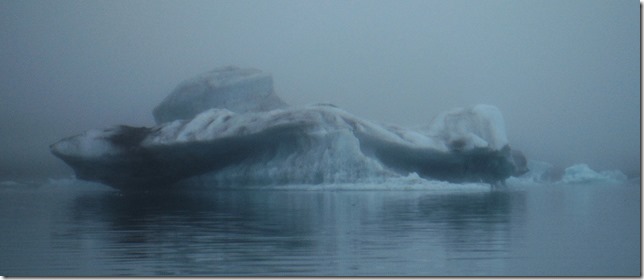
After we were on-shore, waiting for our pick-up flight, we were again startled by another roll-over. This time it was a truck-sized ‘berg just 50 yards off-shore, deciding to re-position itself in a sleepy tumble literally at our feet.
Starting to move….
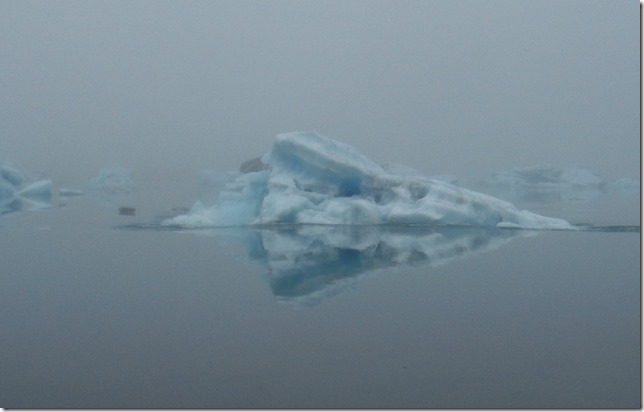
Tipping toward the camera…
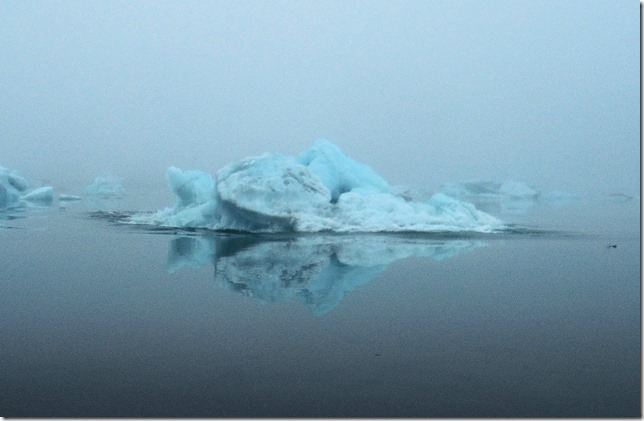
Rolling under-water, and the beginning of the wave…
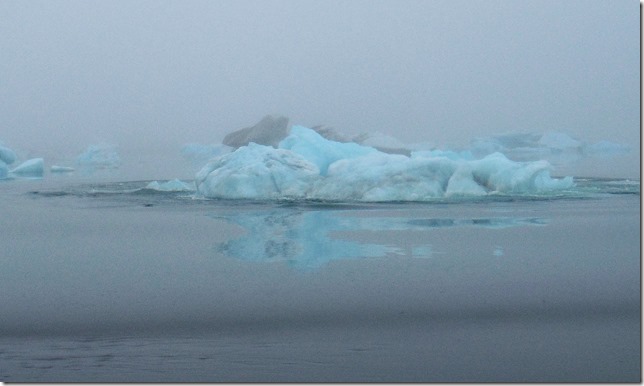
Bobbing back up a bit, and the wave starts to break at the shoreline…
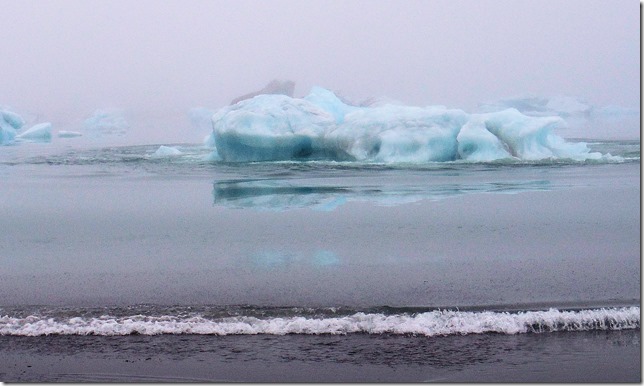
What a treat.
Next, it was time to find out if the fog was too bad to fly in. This would not be a disaster, but certainly a big inconvenience for both us and the tour provider. The alternatives would be to stay in some nearby cabin tents until the weather improved, or to have a water taxi make the long trip out to the lagoon, negotiate the shallow entrance waters and boat us back home. Neither one of them caused us any depth of concern, with our loose schedule.
In between logistics phone calls, we chatted with Libby a bit. She had been guiding here for years, and had never (until today) seen such amazing activity in the lagoon. She had been out many times when there were no breakups or rollovers at all – so it was in a way as amazing for her, the experienced guide, as it was for us, the newbie tourists.
The weather was – from my fixed-wing pilot’s point of view – absolutely skanky. The fog was thick enough that the landing zone would not be visible from above, so it would have to be approached horizontally. If I were the one flying, I wouldn’t be flying. But if helicopters, as I have mentioned, are magic carpets, then their pilots are the true magicians. Mike, our pilot, had made one attempt to come in and was turned back by a “white wall”. Knowing, and seeing, the fog’s “breathing” action, he pulled back for a half-hour and made a second attempt.
By the second try, the fog had again shifted around a bit, and Mike saw his alley through the murk. I saw his landing light first, and then the body of the chopper.
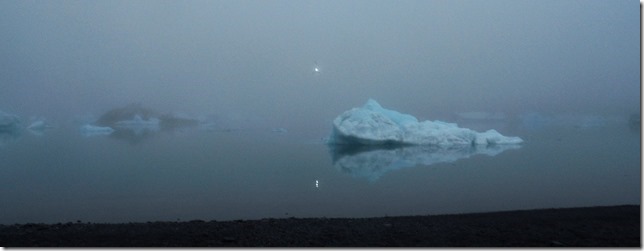
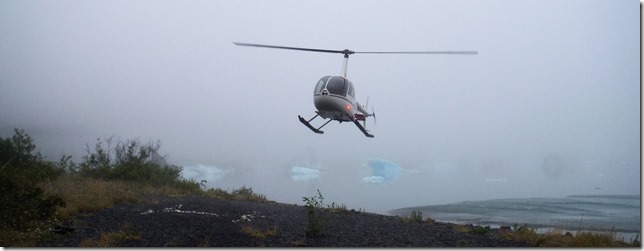
Same spot, same flawless landing. Piece of cake.
Loaded, up, and out again, this time right down on top of the icebergs to move toward some decent air to fly home in.
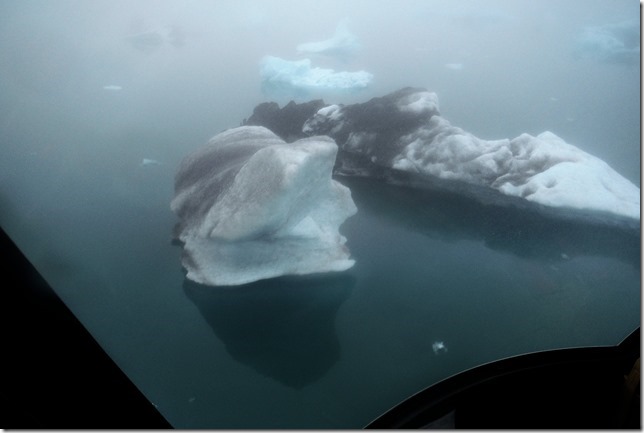
Shortly later, some welcome altitude as we pass over the “ice litter” in the outer lagoon.
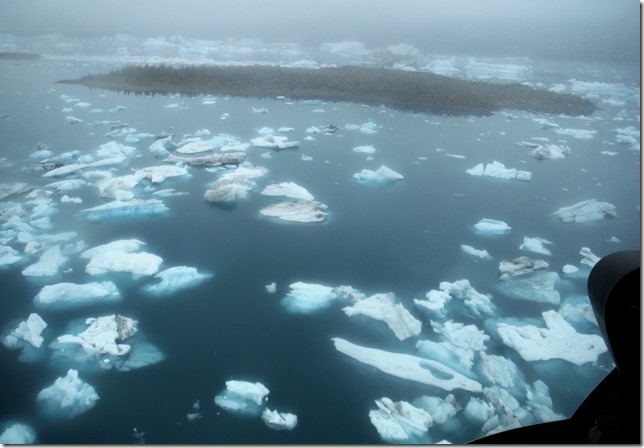
A classic short swing-wing final, a feather-soft touchdown, and we were home.
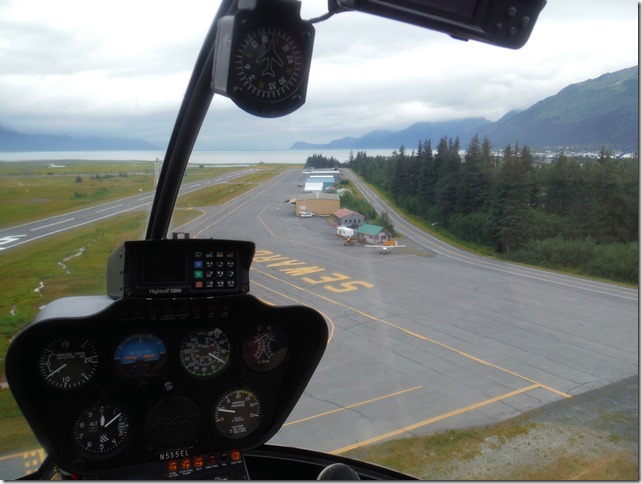
This was a day that will stick in our memories for a LONG time to come. Some things were planned, some things weren’t, and all things were fabulous experiences. We were well past thrilled. The joyful glow stayed with us as we went to bed that night.
I don’t ordinarily do a lot of “plugging”, but this one deserves the best recommendation I can give. Adventure 60 North, adventure60.com, is a class-A outfit that handed us an experience well beyond our expectations. And of course I can’t say enough good things about our guide Libby and our pilot Mike. Nice work, both of you.

What a memorable adventure, especially that wave coming at you! We wanted to paddleboard bear glacier but the weather was rainy and miserable the days we were there but we will most certainly make sure to plan extra time (and money) for it on our next trip there. As for that earthquake, I remember we were sitting in the RV working on the computers in Seward when it happened so it was very noticeable to us. It makes me wonder what it was like for anyone on a glacier or sight seeing tour at that moment. Pretty exciting I would imagine.
Nikki, it was also foggy and slightly rainy when we went in there. Made the time a bit surreal, even spiritual. And, even with all of my past private-pilot flying, getting in and out through that stuff in the helicopter was truly memorable. Impressive flying.
Thanks for the transporting us to the glacier’s magic. We’ve been to the landward side of Bear, but that is tame beyond belief. Although you were not pleased with your photos, the words painted an excellent picture of your day. Next year is our turn for a 4-5 month odyssey to Alaska – our first without doing any workamping or volunteering. Thanks for the “appetizer”.
Thanks for your posts.
Hope you get a chance to visit Valdez on the way out. Lots of beautiful sites & kayak opportunities down here.
Also take time to take a look at Sheep Mountain on the Glenn Hwy. Fun stop…
Yes, Carole and thanks for the encouragement. One of our few “plans” is to spend some time in Valdez, somewhere around third week in August. And we will check out Sheep Mountain for sure.
OK, this one was very exciting.
Happy to see you and Karin enjoying your trip.
Love yu.
L.
Wow! I felt like I was there with you guys. Not just the photos, which were absolutely amazing, but your narrative made the whole adventure come to life. You had a truly once in a lifetime experience. Thank you so much for taking us along.
Fantastic. Thanks for the great pictures. I was so envious. Glad you took the trip it was so much fun to read about it. A real gift for us arm chair travelers.